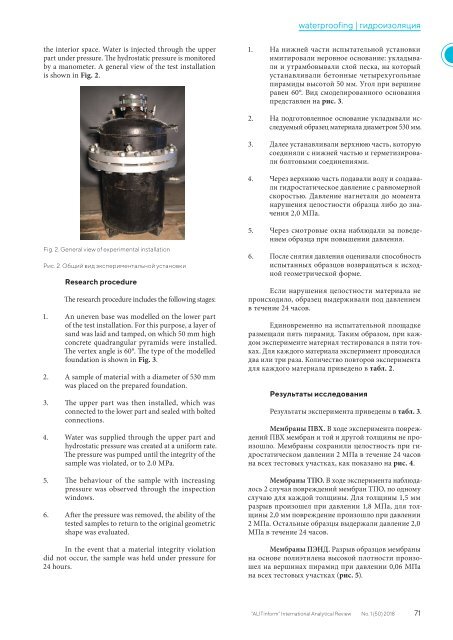AlitInform 50
“ALITinform” is a periodical that covers different aspects in production and applications of cement, concrete, and dry building mixtures. Pages of this journal offer contributions from leading Russian and International scientists, technologists and leading professionals, news from the stock markets, research laboratories, latest elaborations by producers and suppliers of modern building materials and equipment. The magazine goal is to unite on its pages the articles of the leading Russian and International specialists in the field of cement, concrete, dry building mixtures; latest news of the Russian and world building materials market, the traditions of peer-reviewed Russian scientific magazines and innovative informational approach of the contemporary printed media. The prime focus is on developments serving the purpose of rationalization of production, reduction of energy consumption, enhancement of quality and improvement of environmental safety. _______________________________________
“ALITinform” is a periodical that covers different aspects in production and applications of cement, concrete, and dry building mixtures. Pages of this journal offer contributions from leading Russian and International scientists, technologists and leading professionals, news from the stock markets, research laboratories, latest elaborations by producers and suppliers of modern building materials and equipment.
The magazine goal is to unite on its pages the articles of the leading Russian and International specialists in the field of cement, concrete, dry building mixtures; latest news of the Russian and world building materials market, the traditions of peer-reviewed Russian scientific magazines and innovative informational approach of the contemporary printed media. The prime focus is on developments serving the purpose of rationalization of production, reduction of energy consumption, enhancement of quality and improvement of environmental safety.
_______________________________________
Create successful ePaper yourself
Turn your PDF publications into a flip-book with our unique Google optimized e-Paper software.
waterproofing | гидроизоляция<br />
the interior space. Water is injected through the upper<br />
part under pressure. The hydrostatic pressure is monitored<br />
by a manometer. A general view of the test installation<br />
is shown in Fig. 2.<br />
1. На нижней части испытательной установки<br />
имитировали неровное основание: укладывали<br />
и утрамбовывали слой песка, на который<br />
устанавливали бетонные четырехугольные<br />
пирамиды высотой <strong>50</strong> мм. Угол при вершине<br />
равен 60°. Вид смоделированного основания<br />
представлен на рис. 3.<br />
2. На подготовленное основание укладывали исследуемый<br />
образец материала диаметром 530 мм.<br />
3. Далее устанавливали верхнюю часть, которую<br />
соединяли с нижней частью и герметизировали<br />
болтовыми соединениями.<br />
4. Через верхнюю часть подавали воду и создавали<br />
гидростатическое давление с равномерной<br />
скоростью. Давление нагнетали до момента<br />
нарушения целостности образца либо до значения<br />
2,0 МПа.<br />
Fig. 2. General view of experimental installation<br />
Рис. 2. Общий вид экспериментальной установки<br />
Research procedure<br />
The research procedure includes the following stages:<br />
1. An uneven base was modelled on the lower part<br />
of the test installation. For this purpose, a layer of<br />
sand was laid and tamped, on which <strong>50</strong> mm high<br />
concrete quadrangular pyramids were installed.<br />
The vertex angle is 60°. The type of the modelled<br />
foundation is shown in Fig. 3.<br />
2. A sample of material with a diameter of 530 mm<br />
was placed on the prepared foundation.<br />
3. The upper part was then installed, which was<br />
connected to the lower part and sealed with bolted<br />
connections.<br />
4. Water was supplied through the upper part and<br />
hydrostatic pressure was created at a uniform rate.<br />
The pressure was pumped until the integrity of the<br />
sample was violated, or to 2.0 MPa.<br />
5. The behaviour of the sample with increasing<br />
pressure was observed through the inspection<br />
windows.<br />
6. After the pressure was removed, the ability of the<br />
tested samples to return to the original geometric<br />
shape was evaluated.<br />
In the event that a material integrity violation<br />
did not occur, the sample was held under pressure for<br />
24 hours.<br />
5. Через смотровые окна наблюдали за поведением<br />
образца при повышении давления.<br />
6. После снятия давления оценивали способность<br />
испытанных образцов возвращаться к исходной<br />
геометрической форме.<br />
Если нарушения целостности материала не<br />
происходило, образец выдерживали под давлением<br />
в течение 24 часов.<br />
Единовременно на испытательной площадке<br />
размещали пять пирамид. Таким образом, при каждом<br />
эксперименте материал тестировался в пяти точках.<br />
Для каждого материала эксперимент проводился<br />
два или три раза. Количество повторов эксперимента<br />
для каждого материала приведено в табл. 2.<br />
Результаты исследования<br />
Результаты эксперимента приведены в табл. 3.<br />
Мембраны ПВХ. В ходе эксперимента повреждений<br />
ПВХ мембран и той и другой толщины не произошло.<br />
Мембраны сохранили целостность при гидростатическом<br />
давлении 2 МПа в течение 24 часов<br />
на всех тестовых участках, как показано на рис. 4.<br />
Мембраны ТПО. В ходе эксперимента наблюдалось<br />
2 случая повреждений мембран ТПО, по одному<br />
случаю для каждой толщины. Для толщины 1,5 мм<br />
разрыв произошел при давлении 1,8 МПа, для толщины<br />
2,0 мм повреждение произошло при давлении<br />
2 МПа. Остальные образцы выдержали давление 2,0<br />
МПа в течение 24 часов.<br />
Мембраны ПЭНД. Разрыв образцов мембраны<br />
на основе полиэтилена высокой плотности произошел<br />
на вершинах пирамид при давлении 0,06 МПа<br />
на всех тестовых участках (рис. 5).<br />
“ALITinform” International Analytical Review No. 1 (<strong>50</strong>) 2018<br />
71



